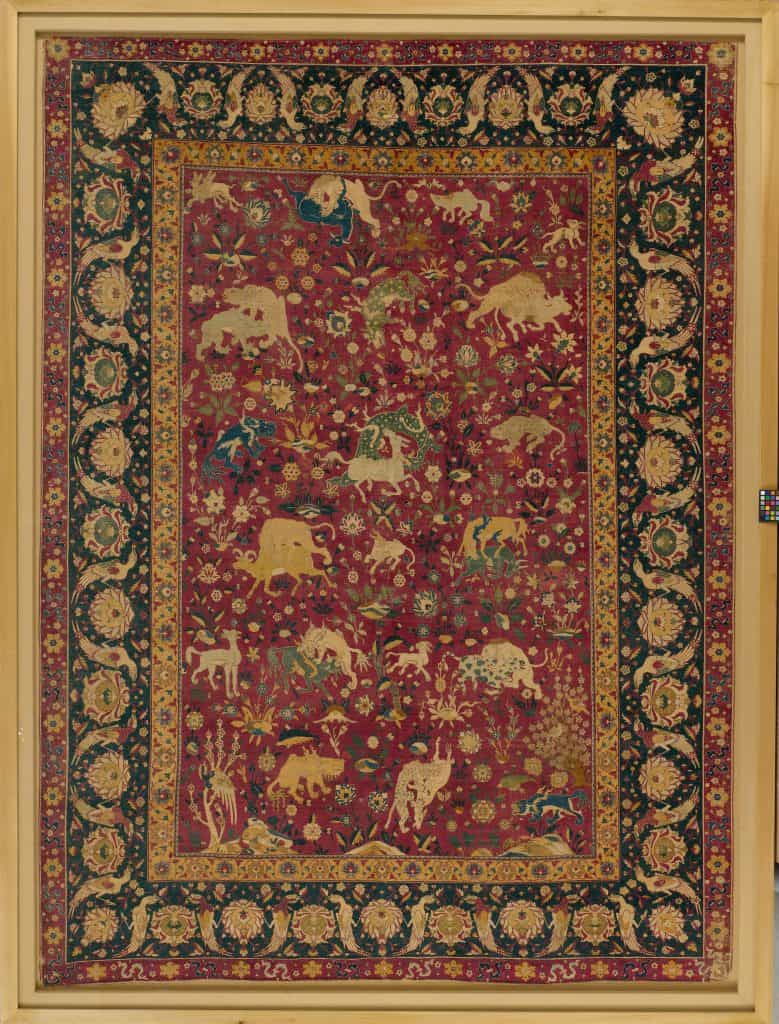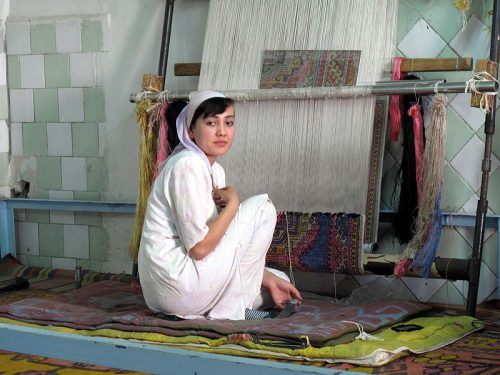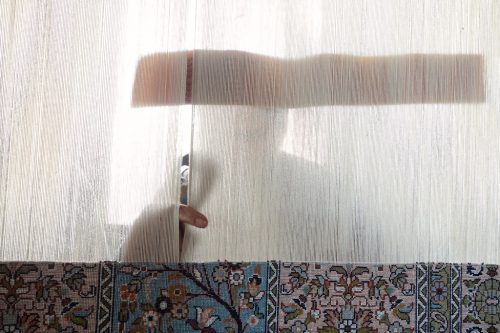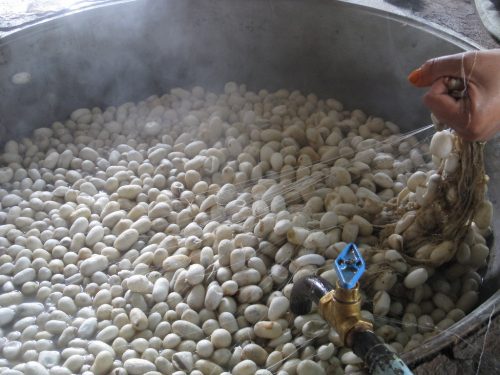Explore the luxurious world of silk carpets, where every weave tells a story of heritage, culture, and unmatched craftsmanship.

Silk carpets, renowned for their luxurious appeal and intricate craftsmanship, have long been considered the epitome of elegance and sophistication in the world of textiles. These exquisite creations are woven from fine silk threads, which give the carpets their signature sheen and softness, making them highly coveted as symbols of wealth and status.
The painstaking process of crafting a silk carpet involves thousands of hours of skilled labour, with artisans meticulously knotting each thread to create complex patterns and designs that often tell stories or symbolize cultural beliefs. Beyond their aesthetic beauty, silk carpets hold global significance as masterpieces of artistic excellence.
They have historically adorned the palaces of royalty, served as diplomatic gifts between nations, and been treasured heirlooms passed down through generations, reflecting the timeless allure and cultural importance of this ancient craft.
Major Carpet Hubs in India
Rajasthan (Jaipur, Bikaner, Ajmer)
Rajasthan is known for its hand-knotted woollen carpets, especially in Jaipur, Ajmer, and Bikaner. Carpet weaving in the region dates back to the Mughal era when Afghan weavers settled here in the 17th century. Rajasthan carpets are famous for their vibrant colours and geometric patterns, gaining global popularity.
Uttar Pradesh (Agra, Bhadohi, Mirzapur)
Uttar Pradesh is a key carpet-producing region, with Agra, Bhadohi, and Mirzapur as major hubs. Agra, a historic centre of carpet weaving during Mughal India, is known for its Persian-inspired designs and use of natural vegetable dyes. Bhadohi carpets are recognized for their unique, locally developed patterns, often incorporating motifs inspired by the Taj Mahal.
Kashmir
Kashmir is renowned for its hand-knotted silk and woollen carpets, which are celebrated for their softness and intricate craftsmanship. These carpets often feature Persian-inspired designs and have their origins in the Mughal period. Kashmir remains a major centre for high-quality silk carpet weaving.
Carpet Weaving Techniques
- Hand-Knotted Carpets
Introduced by the Mughals, this method produces luxurious carpets with intricate patterns. While initially influenced by Turkish and Persian designs, the technique has been adapted over time, particularly in Kashmir. - Hand-Tufted Carpets
In this method, the carpet pile is injected into a backing material using a tufting gun, then bonded with a secondary backing cloth for stability. These carpets can feature either loop pile or cut pile designs. - Hand-Woven Carpets
This broad category includes both knotted and flat-weave carpets. The quality is judged by the tightness of the weave and knot density, with Persian carpets being a well-known example.
Historical Background of Weaving Silk Carpets
The history of silk carpet weaving is deeply rooted in ancient civilizations, with its origins tracing back to Persia, China, and India—three of the most significant centres of silk production and textile artistry. In Persia, the tradition of weaving silk carpets dates back to the early centuries of the Common Era, where these exquisite carpets were prized for their intricate designs and luxurious feel. Similarly, in China, the art of silk weaving flourished during the Tang and Ming dynasties, with silk carpets being crafted for imperial palaces and temples.
In India, the origin of the art of weaving Indian carpets may be dated back to the early 16th century, when the Mughal Empire governed India. The dearth of Persian-quality furniture in Emperor Babar’s palace was a source of frustration for the Mughal dynasty’s ruler, Babar. He longed for the comfort and indulgence of soft Persian carpets.
After Babar came to Akbar, the first Mughal emperor. Akbar was known to have a keen appreciation for the aesthetic arts. He imported the greatest carpet weavers from Persia to Agra. The Persian weavers established their businesses in the cities of Delhi, Agra, and Lahore in India. They used motifs from renowned Persian carpets such as Heart, Isfahat, Kashan, and Kimran to inspire the weaving of exquisite carpets. In later years,
Akbar instructed his captives in the craft of carpet making. Soon after, the convicts began producing some of the best carpets in the nation—carpets that were so high-quality that they even surpassed the work of Persian weavers. As a result, the carpet weaving business in India grew from a small group of Persian weavers to the whole country.
The Silk Road, the ancient network of trade routes that connected the East and West, played a pivotal role in the spread of silk and carpet-making techniques. This vast exchange of goods and ideas allowed the intricate designs and superior craftsmanship of silk carpets to reach new markets, making them highly coveted in Europe and the Middle East. As symbols of wealth and power, silk carpets became integral to royal courts, often used to decorate palaces, enhance the grandeur of ceremonies, and signify diplomatic ties between nations.

They were also valuable commodities in trade, with rulers and merchants alike using them as gifts to forge alliances or demonstrate their wealth and cultural refinement. Through the centuries, silk carpets have remained enduring symbols of artistic excellence, luxury, and cultural exchange.
The Process
The crafting process of silk carpets is a meticulous and labour-intensive journey that begins with the cultivation of silkworms, which are raised specifically for their fine silk fibres. These silkworms spin cocoons from which the silk is harvested, a delicate process that involves unwinding the silk threads from each cocoon.
Locals in Kashmir refer to the carpet factory as the Kharkhaana. This is the area where weavers collaborate to create works of art, and the name comes from the Kashmiri word for “workplace.” When working on a single carpet, families may sometimes sit together on it as it goes through its many stages of completion.
A single carpet often takes an average of two years to finish. Depending on its dimensions and pattern, a carpet may require more time than that. Carpet production is a three-stage process that involves many individuals, beginning with the designer, moving on to the dyer, then the weaver, and lastly, concluding with a trader who distributes the finished products to customers throughout the globe.
Talim is the first step in designing the carpet. The patterns are fine-tuned, the colours are selected, and a conclusion is reached on the design of the carpet. The talim is the textual code, also known as the carpet language, which the weavers must follow when creating the carpet. After the pattern has been approved and the colours selected, the yarn is next sent to be dyed.
After that, the yarn that has been coloured is let out to dry in the open air and sunshine. Now the pattern and the yarns are sent to the carpet weaver, who sets up his loom by the instructions. The weaver is responsible for laying the groundwork for the warps and wefts. The length of the carpet is held together by thick, sturdy threads called warps.

These warps might be made of cotton, wool, or silk. Wefts are threads that are parallel to the warps and go from one side to the other by going under and over the warps. Every Kashmir carpet is woven by hand by tying knots on the warp. There are several varieties of knots used in the weaving of carpets, most of which are symmetrical or asymmetrical, with the latter being the most typical kind.
There is a one-to-one relationship between the number of knots in the carpet and the carpet’s overall worth. The number of knots that are tied into a carpet in Kashmir is measured in terms of its knot density, which is the number of knots that are packed into one square inch.
Weaving generally starts at the bottom of the loom, and the first thing that is done is to put several wefts through the warps to create a foundation from which to work. The next step is to wrap successive sets of nearby warps with knots made of coloured wool, cotton, or silk threads and bind them in rows. The pile of the carpet is created by these knots, which grow more numerous as additional rows are knotted to the foundation. To maintain the stability of the knots, one or more shoots of weft are passed in between each row of knots.
After that, a tool that looks like a comb and is called a comb beater is used to further condense and secure the newly woven row by beating down the wefts. The knot count of a handmade carpet may range anywhere from 16 to 800 knots per square inch, and this wide range is due to factors such as the fineness of the weave, the quality of the materials, and the competence of the weavers. Whenever the carpet is finished, the warp ends will have formed the fringes, which may be finished with weft facing, tasselling, or another method of securing them.
Pattern designing is the next crucial stage, where skilled artisans draw out the intricate designs that will be woven into the carpet. These patterns often reflect cultural motifs, historical narratives, or symbolic elements, and serve as a blueprint for the weaving process.

The actual weaving of a silk carpet involves the use of traditional techniques such as the Persian or Turkish knots. In the Persian knot (also known as the asymmetrical knot), the yarn is looped around one warp thread and then passed under the adjacent warp thread, creating a finer and more detailed texture.
The Turkish knot (or symmetrical knot) involves looping the yarn around two adjacent warp threads, resulting in a thicker and more durable texture. The choice of knotting technique significantly influences the carpet’s texture, density, and overall durability.
Cultural Significance
Silk carpets hold deep cultural and spiritual significance in various societies, transcending their function as mere decorative items to become symbols of heritage, prosperity, and sacred tradition. In many cultures, particularly in Persia, India, and China, silk carpets are used in religious ceremonies, often laid out in places of worship or during important rituals to signify reverence and sanctity.
These carpets, with their intricate designs and luxurious materials, are also treasured as family heirlooms, passed down through generations as symbols of continuity, wealth, and cultural identity. The act of gifting a silk carpet is considered a gesture of great honour and respect, often marking significant life events such as weddings or the establishment of a new home.
Beyond their physical beauty, silk carpets are rich with symbolic meaning and often serve as mediums of storytelling. Each design element woven into a silk carpet can convey a narrative or cultural belief, from depictions of the “Tree of Life,” symbolizing immortality and eternal life, to intricate floral patterns representing paradise or divine beauty. In many cases, these carpets reflect the history, religion, and social values of the people who create and use them.
For instance, Persian carpets might tell stories of ancient kings and epic battles, while Indian carpets may depict scenes from Hindu mythology or local folklore. The ability of silk carpets to encapsulate and convey these rich cultural narratives makes them not just objects of luxury, but also important cultural artefacts that preserve and communicate the traditions and beliefs of the societies from which they originate.
The preservation of this ancient craft is crucial for future generations, not only to maintain the artistry and skill involved in silk carpet weaving but also to safeguard the cultural narratives and traditions they represent. In an era where mass production and synthetic materials dominate, the meticulous handcrafting of silk carpets stands as a reminder of the value of patience, skill, and cultural continuity.
By supporting and preserving this art form, we ensure that the stories, traditions, and exquisite craftsmanship embedded in each silk carpet continue to be appreciated and cherished by generations to come, keeping this rich heritage alive and vibrant in an ever-changing world.
Meaningful Patterns in Carpets
- Cypress Tree: Eternal life
- Peacock: Sacred symbol
- Tree of Life: Immortality
- Pomegranate: Abundance
- Lion: Victory
- Hourglass: Time passing
- Intricate medallion design: A single symmetrical motif, often shaped as a star, circle, quatrefoil, or octagon.
FAQS for Silk Carpets
- How can you identify a real silk carpet?
A genuine silk carpet will have a high knot count, typically with at least 200 knots per square inch (KPSI), though many have more than 500 KPSI. The high knot count results in a detailed and intricate design, which is a key indicator of authenticity. - Do handmade silk carpets help with sound absorption?
Yes, handmade silk carpets are dense with no gaps between the strands, which allows them to reduce sound frequency and absorb noise effectively. - Are silk fibres more durable than other natural fibres?
Yes, silk fibres have the longest durability when compared to other natural fibres.
Where to buy Silk Rugs
Here’s a list of Indian shops where you can buy silk rugs:
- Cottage Industries Exposition (CIE) – Known for their premium quality handwoven silk carpets, CIE has outlets across major cities in India.
- Omar Khayyam Carpets, Srinagar – A well-known shop in Kashmir, specializing in handmade silk carpets with traditional Kashmiri designs.
- Carpet Cellar, Delhi – A luxury store in Delhi offering a curated selection of silk rugs, including antique and modern designs.
- Kalra’s Cottage Industry, Jaipur – Famous for its high-quality silk and wool rugs, this Jaipur-based shop offers a range of intricately designed carpets.
- Kashmir Oriental Carpet Enterprises, Delhi – Specializing in traditional Kashmiri silk carpets, this store is a popular choice for those looking for authentic pieces.
- Carpet Kingdom, Bangalore – Known for their collection of high-end silk rugs, Carpet Kingdom offers both traditional and contemporary designs.
- Kashmir Carpet House, Mumbai – Located in the heart of Mumbai, this shop offers a wide selection of handmade silk carpets from Kashmir.
- Rugs and Beyond, Delhi – An online and physical store offering luxury silk carpets from Kashmir, with a focus on quality and traditional craftsmanship.
- Shah Carpets, Varanasi – A popular store in Varanasi offering a wide selection of silk carpets, known for their intricate designs and vibrant colours.
- The Carpet House, Agra – Specializing in handmade silk carpets, The Carpet House is known for its traditional Persian and Indian designs.
International Stores where you can buy Silk Carpets
- Luxury Department Stores – High-end retailers like Harrods, Neiman Marcus, or Bergdorf Goodman often carry select silk rugs.
- Custom Rug Makers – For bespoke designs, you can work with custom rug makers like Rug Artisan or The Rug Company to create a silk rug tailored to your style.
These stores offer a blend of traditional craftsmanship and modern designs, with a strong focus on the unique artistry of Indian silk rugs.
Read more: Latest



